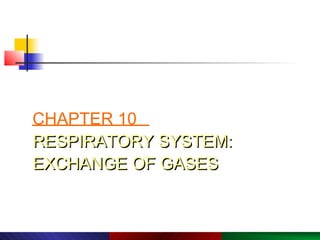
Respiratory system
- 1. PowerPoint® Lecture Slide Presentation by Robert J. Sullivan, Marist College Human Biology CHAPTER 10 RESPIRATORY SYSTEM: EXCHANGE OF GASES Copyright © 2003 Pearson Education, Inc. publishing as Benjamin Cummings.
- 2. Human Respiratory System Figure 10.1
- 3. Components of the Upper Respiratory Tract Figure 10.2
- 4. Upper Respiratory Tract Functions Passageway for respiration Receptors for smell Filters incoming air to filter larger foreign material Moistens and warms incoming air Resonating chambers for voice
- 5. Components of the Lower Respiratory Tract Figure 10.3
- 6. Lower Respiratory Tract Functions: Larynx: maintains an open airway, routes food and air appropriately, assists in sound production Trachea: transports air to and from lungs Bronchi: branch into lungs Lungs: transport air to alveoli for gas exchange
- 7. Gas Exchange Between the Blood and Alveoli Figure 10.8A
- 8. Respiratory Cycle Figure 10.9
- 9. Measurement of Lung Capacity Figure 10.10A
- 10. Regulation of Breathing Figure 10.13
- 11. Regulation of Breathing: Nervous System Involvement Carotid and aortic bodies: sensitive to carbon dioxide, pH, and oxygen levels Conscious control: resides in higher brain centers; ability to modify breath is limited
- 12. Disorders of Respiratory System Reduced air flow: asthma, emphysema, bronchitis Infections: pneumonia, tuberculosis, botulism Lung cancer Congestive heart failure Cystic fibrosis
- 13. Breathing disorders One breathing disorder: Asthma or Bronchitis One possible cause Prevention Treatment
- 14. Process of Breathing: Pressure Gradient Inspiration/Expiration: air in/air out Cycle: Relaxed state: diaphragm and intercostal muscles relaxed Inspiration: diaphragm contracts, pulling muscle down, intercostal muscles contract elevating chest wall and expanding volume of chest, lowering pressure in lungs, pulling in air Expiration: muscles relax, diaphragm resumes dome shape, intercostal muscles allow chest to lower resulting in increase of pressure in chest and expulsion of air
- 15. Measurement of Lung Function Lung volumes and vital capacity Tidal volume: volume of air inhaled and exhaled in a single breath Dead space volume: the air that remains in the airways and does not participate in gas exchange Vital capacity: the maximal volume that can be exhaled after maximal inhalation Inspiratory reserve volume: the amount of air that can be inhaled beyond the tidal volume
- 16. Measurement of Lung Function (cont.) Lung volumes and vital capacity (continued) Expiratory reserve volume: the amount of air that can be forcibly exhaled beyond the tidal volume Residual volume: the amount of air remaining in the lungs, even after a forceful maximal expiration Measurement: spirometer
- 17. Gas Exchange & Transport: A Passive Process Gases diffuse according to their partial pressures External respiration: gases exchanged between air and blood Internal respiration: gases exchanged with tissue fluids Oxygen transport: bound to hemoglobin in red blood cells or dissolved in blood plasma Carbon dioxide transport: dissolved in blood plasma, bound to hemoglobin, or in the form of
- 18. Regulation of Breathing: Nervous System Involvement Respiratory center in the medulla oblongata: establishes basic breathing pattern Chemical receptors: monitor carbon dioxide, hydrogen ions, and oxygen levels Medulla: sensitive to hydrogen ions in cerebrospinal fluid resulting from carbon dioxide in blood
- 19. Four Respiration Processes Breathing (ventilation): air in to and out of lungs External respiration: gas exchange between air and blood Internal respiration: gas exchange between blood and tissues Cellular respiration: oxygen use to produce ATP, carbon dioxide as waste